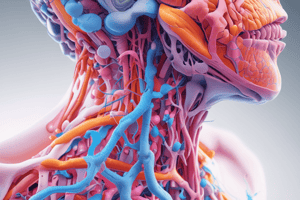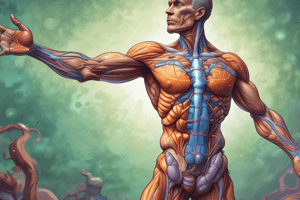Podcast
Questions and Answers
Which type of hormones can diffuse through the phospholipid bilayer of plasma membranes?
Which type of hormones can diffuse through the phospholipid bilayer of plasma membranes?
- Amino acid-based hormones
- Water soluble hormones
- Peptide hormones
- Lipid soluble hormones (correct)
Where are steroid hormones synthesized?
Where are steroid hormones synthesized?
- Pancreas
- Pituitary gland
- Thyroid gland
- Adrenal cortex (correct)
Which hormone is water soluble despite being an amino acid-based hormone?
Which hormone is water soluble despite being an amino acid-based hormone?
- Testosterone
- Thyroid hormone
- Epinephrine (correct)
- Insulin (correct)
What is the role of the first messenger in hormone signaling?
What is the role of the first messenger in hormone signaling?
How do lipid soluble hormones generally exert their effects within target cells?
How do lipid soluble hormones generally exert their effects within target cells?
Which type of hormones are typically bound to plasma proteins during transportation in the bloodstream?
Which type of hormones are typically bound to plasma proteins during transportation in the bloodstream?
Which pathway is initiated by water soluble hormones involving adenylate cyclase?
Which pathway is initiated by water soluble hormones involving adenylate cyclase?
What is a characteristic of thyroid hormone among amino acid-based hormones?
What is a characteristic of thyroid hormone among amino acid-based hormones?
What is the primary mechanism of action for many hormones, as indicated in the content?
What is the primary mechanism of action for many hormones, as indicated in the content?
Which structure primarily monitors calcium levels in the blood for hormone regulation?
Which structure primarily monitors calcium levels in the blood for hormone regulation?
What hormones are stored in the posterior pituitary gland?
What hormones are stored in the posterior pituitary gland?
What does ADH primarily do regarding kidney function?
What does ADH primarily do regarding kidney function?
Which gland is often referred to as the 'master endocrine gland'?
Which gland is often referred to as the 'master endocrine gland'?
What is the primary function of the endocrine system?
What is the primary function of the endocrine system?
How are the anterior pituitary and hypothalamus connected?
How are the anterior pituitary and hypothalamus connected?
What do exocrine glands do?
What do exocrine glands do?
Which of the following is a characteristic of peptide hormones like oxytocin?
Which of the following is a characteristic of peptide hormones like oxytocin?
What role do target cells play in the endocrine system?
What role do target cells play in the endocrine system?
What effect does alcohol have in relation to hormone function?
What effect does alcohol have in relation to hormone function?
Which of the following is a major organ of the endocrine system?
Which of the following is a major organ of the endocrine system?
What is the study of endocrine organs and hormones called?
What is the study of endocrine organs and hormones called?
Which of the following is NOT a function of the endocrine system?
Which of the following is NOT a function of the endocrine system?
Which class of hormones is considered the largest?
Which class of hormones is considered the largest?
How do hormones communicate their effects in the body?
How do hormones communicate their effects in the body?
What condition is characterized by excessive thirst and increased urination?
What condition is characterized by excessive thirst and increased urination?
Which hormonal action does the anterior pituitary NOT regulate?
Which hormonal action does the anterior pituitary NOT regulate?
What is the function of the hypophyseal portal system?
What is the function of the hypophyseal portal system?
Which hormone stimulates the development of the thyroid gland?
Which hormone stimulates the development of the thyroid gland?
What hormone is released from the hypothalamus to regulate ACTH secretion?
What hormone is released from the hypothalamus to regulate ACTH secretion?
What is the primary function of Luteinizing Hormone (LH)?
What is the primary function of Luteinizing Hormone (LH)?
How does Growth Hormone (GH) affect metabolism?
How does Growth Hormone (GH) affect metabolism?
Which of the following hormones is NOT produced by the anterior pituitary?
Which of the following hormones is NOT produced by the anterior pituitary?
What inhibits the release of Prolactin (PRL)?
What inhibits the release of Prolactin (PRL)?
In response to rising levels of glucocorticoids, what feedback mechanism occurs?
In response to rising levels of glucocorticoids, what feedback mechanism occurs?
What role does Gonadotropin-Releasing Hormone (GnRH) play in hormone regulation?
What role does Gonadotropin-Releasing Hormone (GnRH) play in hormone regulation?
What is the primary messenger system activated by most anterior pituitary hormones?
What is the primary messenger system activated by most anterior pituitary hormones?
Which condition results from childhood hypersecretion of Growth Hormone?
Which condition results from childhood hypersecretion of Growth Hormone?
What is the effect of elevated gonadal hormone levels on FSH and LH release?
What is the effect of elevated gonadal hormone levels on FSH and LH release?
What causes acromegaly?
What causes acromegaly?
Which hormone is primarily responsible for stimulating milk production in the breasts?
Which hormone is primarily responsible for stimulating milk production in the breasts?
Flashcards
Hormones
Hormones
Chemical messengers that travel through the bloodstream, binding to specific receptors on target cells to elicit a response.
Exocrine Glands
Exocrine Glands
Glands that release their secretions into ducts, which carry the secretions to specific locations.
Endocrine Glands
Endocrine Glands
Glands that release their secretions (hormones) directly into the bloodstream, without the use of ducts.
Endocrinology
Endocrinology
Signup and view all the flashcards
Hormone Specificity
Hormone Specificity
Signup and view all the flashcards
Target Cells
Target Cells
Signup and view all the flashcards
Hormonal Deficiency
Hormonal Deficiency
Signup and view all the flashcards
Hormonal Excess
Hormonal Excess
Signup and view all the flashcards
Half-Life in Blood
Half-Life in Blood
Signup and view all the flashcards
Metabolism
Metabolism
Signup and view all the flashcards
Hormone Receptor Location
Hormone Receptor Location
Signup and view all the flashcards
Second Messenger
Second Messenger
Signup and view all the flashcards
Mechanism of Hormone Action
Mechanism of Hormone Action
Signup and view all the flashcards
Control of Hormone Release
Control of Hormone Release
Signup and view all the flashcards
Anterior Pituitary Gland
Anterior Pituitary Gland
Signup and view all the flashcards
Hypothalamic-Pituitary Axis
Hypothalamic-Pituitary Axis
Signup and view all the flashcards
Steroids
Steroids
Signup and view all the flashcards
Amino Acid-Based Hormones
Amino Acid-Based Hormones
Signup and view all the flashcards
GPCR and cAMP Mechanism
GPCR and cAMP Mechanism
Signup and view all the flashcards
Lipid-Soluble Hormone Action
Lipid-Soluble Hormone Action
Signup and view all the flashcards
Steroid Transport
Steroid Transport
Signup and view all the flashcards
Amino Acid-Based Hormone Transport
Amino Acid-Based Hormone Transport
Signup and view all the flashcards
Thyroid Hormone Exception
Thyroid Hormone Exception
Signup and view all the flashcards
Target Cells and Receptors
Target Cells and Receptors
Signup and view all the flashcards
Diabetes insipidus
Diabetes insipidus
Signup and view all the flashcards
Hypophyseal Portal system
Hypophyseal Portal system
Signup and view all the flashcards
Hypophyseal Portal System
Hypophyseal Portal System
Signup and view all the flashcards
Primary capillary plexus
Primary capillary plexus
Signup and view all the flashcards
Secondary capillary plexus
Secondary capillary plexus
Signup and view all the flashcards
Releasing and inhibiting hormones
Releasing and inhibiting hormones
Signup and view all the flashcards
Tropic Hormones
Tropic Hormones
Signup and view all the flashcards
Negative Feedback Mechanism
Negative Feedback Mechanism
Signup and view all the flashcards
Gonadotropins
Gonadotropins
Signup and view all the flashcards
Follicle-Stimulating Hormone (FSH)
Follicle-Stimulating Hormone (FSH)
Signup and view all the flashcards
Luteinizing Hormone (LH)
Luteinizing Hormone (LH)
Signup and view all the flashcards
Gonadotropin-Releasing Hormone (GnRH)
Gonadotropin-Releasing Hormone (GnRH)
Signup and view all the flashcards
Growth Hormone (GH)
Growth Hormone (GH)
Signup and view all the flashcards
Growth Hormone-Releasing Hormone (GHRH)
Growth Hormone-Releasing Hormone (GHRH)
Signup and view all the flashcards
Growth Hormone-Inhibiting Hormone (GHIH)
Growth Hormone-Inhibiting Hormone (GHIH)
Signup and view all the flashcards
Prolactin (PRL)
Prolactin (PRL)
Signup and view all the flashcards
Study Notes
Endocrine System
- Controls metabolism, growth, development, and long-term body tissue activity
- Exocrine glands release secretions into ducts (e.g., sweat, salivary, mammary)
- Endocrine glands are ductless, secreting hormones into the extracellular fluid (ECF), which then enter the bloodstream
- Target cells/organs have specific receptors enabling responses to hormones
- Endocrinology studies endocrine organs and hormones
Endocrine Functions
- Regulates cellular metabolism and energy balance
- Controls long-term processes like growth and development, reproduction
- Maintains electrolyte, water, and nutrient balance
Endocrine Major Organs
- Pituitary gland
- Thyroid gland
- Parathyroid gland
- Adrenal gland
- Pineal gland
- Hypothalamus
- Pancreas
- Testes
- Ovaries
Chemical Messengers (Hormones)
- Long-distance chemical messengers traveling in blood
- Local signaling molecules (autocrines, paracrines) are NOT part of endocrine system
- Autocrines affect the secreting cell itself
- Paracrines affect nearby cells
- Hormone types:
- Amino acid-based (amines, peptides, proteins) – mostly water-soluble and circulate freely
- Steroids (derived from cholesterol) – lipid-soluble and often bound to plasma proteins
- Hormones bind to specific receptors on target cells triggering responses
Hormone Action
- Water-soluble hormones bind to membrane receptors, activating intracellular second messengers (e.g., cAMP)
- Lipid-soluble hormones diffuse into cells and bind to intracellular receptors (e.g., inside the nucleus), activating specific genes
Hormone Control of Release
- Humoral stimuli: response to blood levels of ions/nutrients
- Neural stimuli: response to nervous system stimulation (e.g., action potentials)
- Hormonal stimuli: response to other hormones
Specific Endocrine Glands
- Pituitary Gland (Hypophysis):
- Location: sella turcica of the sphenoid bone
- "Master" Endocrine gland—influencing other endocrine organs
Types of pituitary hormones:
- Posterior Pituitary: releases oxytocin and antidiuretic hormone (ADH) from hypothalamic neurons
- Anterior Pituitary: regulated by hypothalamic releasing and inhibiting hormones through the hypophyseal portal system Produces: TSH, ACTH, FSH, LH, PRL, GH. Note that each of these have specific targets and actions.
Studying That Suits You
Use AI to generate personalized quizzes and flashcards to suit your learning preferences.





